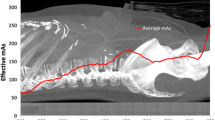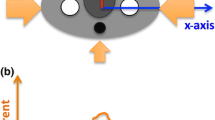Abstract
The aim of this study was to investigate the potential of dose reduction in multidetector computed tomography (MDCT) by current-modulated automatic exposure control (AEC) and to test the reliability of the dose estimation by the conventional CT dosimetry program CT-EXPO, when an average tube current is used. Phantom measurements were performed at a CT system with 64 detector rows for four representative examination protocols, each without and with current-modulated AEC. Organ and effective doses were measured by thermoluminescence dosimeters (TLD) at an anthropomorphic Alderson phantom and compared with those given by the calculation with CT-EXPO. The application of AEC yielded dose reductions between 27 and 40% (TLD measurements). While good linearity was observed between measured and computed effective dose values both without and with AEC, the organ doses showed large deviations between measurement and calculation. The dose to patients undergoing a MDCT examination can be reduced considerably by applying a current-modulated AEC. Dosimetric algorithms using a constant current–time product provide reliable estimates of the effective dose.




Similar content being viewed by others
References
Amis ES Jr, Butler PF, Applegate KE, Birnbaum SB, Brateman LF, Hevezi JM, Mettler FA, Morin RL, Pentecost MJ, Smith GG, Strauss KJ, Zeman RK (2007) American College of Radiology. American College of Radiology white paper on radiation dose in medicine. J Am Coll Radiol 4:272–284
Umweltradioaktivität und Strahlenbelastung im Jahr 2006. Deutscher Bundestag Drucksache 16/6835, 2007, http://dip21.bundestag.de/dip21/btd/16/068/1606835.pdf. Accessed 15 May 2008
Mettler FA (2007) Magnitude of radiation uses and doses in the United States: NCRP Scientific Committee 6-2 Analysis of Medical Exposures. In: Forty-third annual meeting of the National Council on Radiation Protection and Measurement (NCRP) Advances in radiation protection in medicine, pp 9−10
Nishizawa K, Matsumoto M, Iwai K, Maruyama T (2004) Survey of CT practice in Japan and collective effective dose estimation. Nippon Acta Radiol 64:151–158
Greess H, Wolf H, Suess C, Kalender WA, Bautz W, Baum U (2004) Dosisautomatik bei der Mehrzeilen-CT: Phantommessungen und klinische Ergebnisse. Fortschr Röntgenstr 176:862–869
Graser A, Wintersperger BJ, Suess C, Reiser MF, Becker CR (2006) Dose reduction and image quality in MDCT colonography using tube current modulation. AJR:187 September 2006:695–701
Russel MT, Fink JR, Rebeles F, Kanal K, Ramos M, Anzai Y (2008) Balancing radiation dose and image quality: clinical application of neck volume CT. AJNR Am J Neroradiol. doi:10.3174/ajnrA0891
Kalender WA, Buchenau S, Deak P, Kellermeister M, Langner O, van Straten M, Vollmar S, Wilharm S (2008) Technical approaches to the optimisation of CT. Phys Med 24(2):71–79
Stamm G, Nagel HD (2002) CT-Expo − ein neuartiges Programm zur Dosisevaluierung in der CT. Fortschr Rontgenstr 174:1570–1576
Keat N (2005) CT scanner automatic exposure control systems. MHRA Report 05016
Brix G, Lechel U, Glatting G, Ziegler S, Münzing W, Müller S, Beyer T (2005) Radiation exposure of patients undergoing whole-body dual modality 18F-FDG PET/CT examinations. J Nucl Med 46:608–613
ICRU Publication 17 (1970) Radiation dosimetry: X rays generated at potentials of 5 to 150 kV. ICRU, Washington, DC
European Commission (2000) Report EUR 19604 EN: recommendations for patient dosimetry in diagnostic radiology using TLD
Jastrow W (2008) Atlas of human sections in [sic] the internet. Labelling of sections from the visible human project. http://www.uni-mainz.de/FB/Medizin/Anatomie/workshop/englWelcome.html. Accessed 15 May 2008
Huda W, Sandison GA (1984) Estimation of mean organ doses in diagnostic radiology from Rando phantom measurements. Health Physics 47:463–467
ICRP Publication 60 (1991) 1990 recommendations of the International Commission on Radiological Protection. Annals of the ICRP vol 21/1-3. Elsevier Science, Oxford
Taylor B, Kuyatt C (2001) Guidelines for evaluating and expressing the uncertainty of NIST measurement results. National Institute of Standards and Technology, Gaithersburg, MD. http://physics.nist.gov/Pubs/guidelines/TN1297/tn1297s.pdf. Accessed 15 May 2008
Aschan C (1999) Applicability of thermoluminescent dosimeters in x-ray organ dose determination and in the dosimetry of systemic and boron neutron capture radiotherapy. University of Helsinki HU-P-D77
Zankl M, Panzer W, Drexler G (1991) The calculation of dose from external photon exposures using reference human phantoms and Monte Carlo methods. Part IV. Organ doses from tomographic examinations. GSF report 30/91. Neuherberg
Galanski M, Nagel HD, Stamm G (2001) CT-Expositionspraxis in der Bundesrepublik Deutschland. RoFo 173:R1–R66
Nagel HD, Galanski M, Hidajat N, Maier W, Schmidt T (2002) Radiation exposure in computed tomography – fundamentals, influencing parameters, dose assessment, optimization, scanner data, terminology, 4th edn. CTB, Hamburg
Brix G, Lechel U, Veit R, Truckenbrodt R, Stamm G, Coppenrath EM, Griebel J, Nage HD (2004) Assessment of a theoretical formalism for dose estimation in CT: an anthropomorphic phantom study. Eur Radiol 14:1275–1284
Hidajat N, Vogel T, Schröder RJ, Felix R (1996) Berechnete Organdosen und effektive Dosis für die computertomographische Untersuchung des Thorax und Abdomens: Sind diese Dosen realistisch. RoFo 164:382–387
Author information
Authors and Affiliations
Corresponding author
Rights and permissions
About this article
Cite this article
Lechel, U., Becker, C., Langenfeld-Jäger, G. et al. Dose reduction by automatic exposure control in multidetector computed tomography: comparison between measurement and calculation. Eur Radiol 19, 1027–1034 (2009). https://doi.org/10.1007/s00330-008-1204-6
Received:
Accepted:
Published:
Issue Date:
DOI: https://doi.org/10.1007/s00330-008-1204-6




